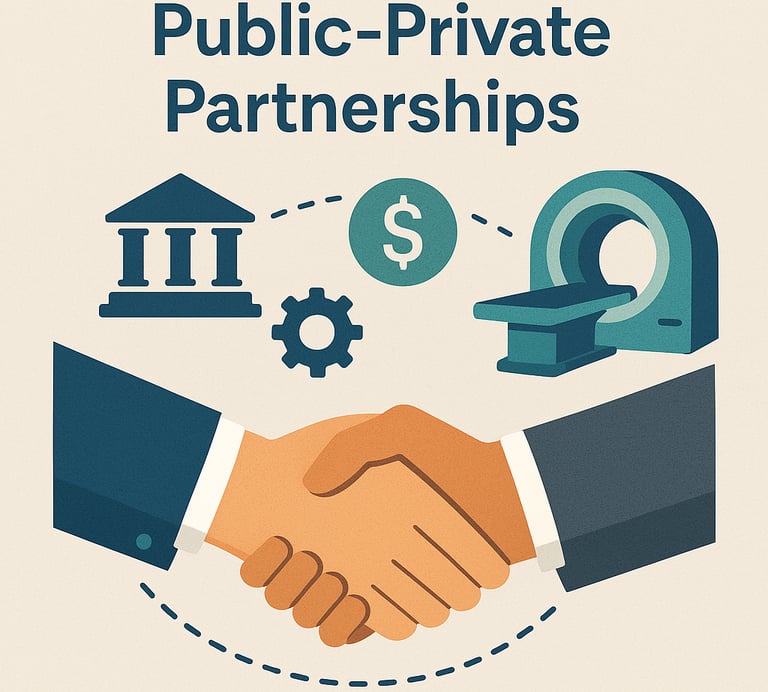Public-Private Partnerships (PPPs) in Healthcare: Enhancing Medical Equipment Access
Public-Private Partnerships (PPPs) have emerged as a vital strategy to bridge gaps in healthcare infrastructure, particularly in acquiring and managing medical equipment. These collaborations allow governments to leverage private sector efficiency, investment, and technological expertise while ensuring broader healthcare access. By reducing the financial burden on the public sector and streamlining service delivery, PPPs play a crucial role in strengthening healthcare systems worldwide.
3/29/20252 min read


Understanding PPPs in Healthcare
A Public-Private Partnership in healthcare is a contractual agreement between a government entity and a private company to provide healthcare services, infrastructure, or equipment. The private sector invests in medical technology and equipment, while the government ensures accessibility and affordability for the public.
PPP models vary, including:
Build-Operate-Transfer (BOT): Private firms build and manage medical facilities or services for a set period before transferring ownership to the government.
Revenue-Sharing Models: Both parties share revenues from healthcare services, reducing costs for public hospitals while ensuring profitability for the private partner.
Managed Equipment Services (MES): Private companies procure, maintain, and upgrade medical equipment while hospitals focus on patient care.
Case Study: India-Philips Healthcare Partnership
One of the most notable PPP success stories is the partnership between the Indian government and Philips Healthcare, launched in 2015. This initiative aimed to improve diagnostic imaging services, particularly in rural and underserved regions.
How It Worked:
Philips Healthcare installed and maintained MRI and CT scanners in public hospitals across India.
The government provided space and ensured subsidized pricing for patients.
A revenue-sharing model was implemented, where both the government and Philips benefited financially while ensuring affordable diagnostics.
Impact:
Increased access to advanced diagnostic services for millions of rural patients.
Reduced patient costs compared to private hospitals.
Improved early detection of diseases like cancer and neurological disorders, leading to better treatment outcomes.
Benefits of PPPs in Medical Equipment Procurement
Cost Efficiency – Governments avoid large upfront costs while ensuring equipment remains up-to-date through private sector investments.
Technology Advancement – Private firms bring cutting-edge innovations, improving diagnosis and treatment capabilities.
Improved Service Delivery – PPPs reduce waiting times, enhance equipment maintenance, and ensure continuous availability of critical medical devices.
Sustainability – Long-term contracts encourage stable healthcare improvements rather than short-term fixes.
Challenges in PPP Implementation
Despite their advantages, PPPs face several challenges, including:
Regulatory Hurdles: Complex bureaucratic processes can delay projects.
Financial Risks: Poorly structured contracts can lead to financial losses for either party.
Equity Concerns: Rural and low-income areas may still struggle with access if services are not evenly distributed.
Long-Term Commitment Issues: Governments may face difficulties maintaining long-term partnerships due to political and economic changes.
Future Outlook for PPPs in Healthcare
As global healthcare demands increase, PPPs are expected to expand, incorporating:
AI and Telemedicine – Enhancing remote diagnostics through public-private collaborations.
Sustainable Financing Models – Using blended finance (grants, loans, private investment) to fund projects.
Localized Manufacturing – Encouraging local production of medical equipment through joint ventures, reducing reliance on imports.
Conclusion
Public-Private Partnerships are revolutionizing healthcare by making essential medical equipment more accessible and affordable. While challenges remain, strategic planning and policy support can enhance their effectiveness. As seen in India’s collaboration with Philips Healthcare, well-executed PPPs can bridge healthcare gaps, ensuring life-saving technologies reach those who need them most.
